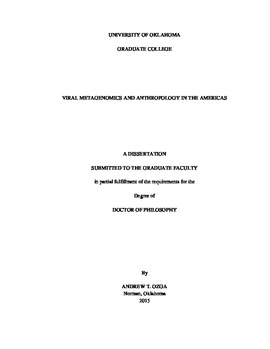| dc.description.abstract | Viruses are the most abundant and diverse biological entities on earth. As humans, we could not exist without them. For billions of years they have been the unseen mediators of microbial and multicellular life. They are in the air, water, dirt and within every living thing on the planet. Although they are not technically alive since all viruses need a host cell to replicate, they outnumber our own cells an estimated 100 to 1 and therefore cannot be undervalued in their importance to human health and biology.
Viruses are in close contact with humans from the moment we are born and as anthropologists we have commonly examined the cultural, social and political implications and responses of human viral infections. Yet there is so much untapped research potential when it comes to viruses. There are essentially five subject areas to discuss when addressing viruses from an anthropological perspective (Figure A1). First is that of host identity. Viruses are an integral part of who we are. This human-virus connection extends back hundreds of thousands of years, as these infectious agents are deeply ingrained within our genomes. In the first chapter I integrate literature of microbiology, virology and many others to posit that the traditional visual metaphor of the tree of life is inadequate and we would be better suited to describe each branch as its own treehouse built upon microbial and viral foundations. A second subject area is that of novelty. In other words, what the discoveries of novel viruses and understanding of understudied viral ecosystems can contribute to our definition of the human superorganism. In the second chapter I address novelty and future research by examining all of the current viral taxonomic information and their associations within the field of anthropology. Next generation sequencing of organisms capable of zoonotic transmission could identify viruses that may eventually be the next great health risk to humans.
The third subject area that intersects viruses and anthropology is host history. In the past, viruses have been used to study complex human migratory patterns but this technique has yet to be fully realized within a viral metagenomic dataset. In chapter three, I use gut viral information from four populations in Oklahoma (Cheyenne and Arapaho) and Peru (Matses, Chincha, Tambo de Mora) in order to address the question of whether gut viral proteins are geographically structured. I hypothesize that DNA viruses are unique enough to the host that their sequences are closely tied to the geographic origin of the host. A fourth subject to be addressed is that of human health. Viruses obviously have a tremendous influence on human cells and microbial cells, but there is still much to be uncovered. In chapter four I use gut information from Oklahoma (Cheyenne and Arapaho, Norman) and Peru (Matses) to examine a recently discovered abundant DNA bacteriophage known as crAssphage. I biologically characterize the phage within the three populations by discerning its method of replication, potential microbial hosts, and its association with gut metabolites. I hypothesize that the abundance of crAssphage sequences found within the Cheyenne and Arapaho is not a result of their geography, but a host health association due to a decreased gastrointestinal health state.
The final subject that links anthropology and viruses is the future, which is referred to throughout the document and summarized in the conclusion section. This dissertation provides a thorough literature review, novel data analysis and potential future directions, all of which are intent to stress the unexplored connections between viruses and the field of anthropology. | en_US |
